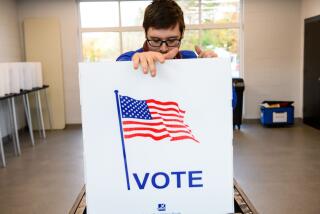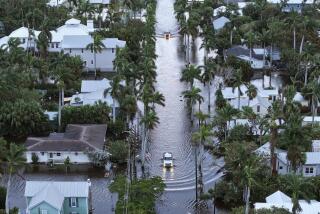A city flees as Gustav nears
NEW ORLEANS — Calling the hurricane bearing down on the Gulf Coast “the mother of all storms,” Mayor C. Ray Nagin on Saturday night declared a mandatory evacuation of this city’s more than 230,000 residents and tourists.
“You need to be getting your butts moving out of New Orleans now,” Nagin said of Hurricane Gustav, a storm the National Hurricane Center said could be a Category 5 -- the top intensity -- when it enters the Gulf of Mexico today.
Gustav, watched closely all week by Louisianians still recovering from Hurricane Katrina in 2005, gained frightening strength Saturday.
The storm, which has killed about 80 people in the Caribbean, hit the mainland of western Cuba in a tobacco farming region Saturday packing 140-mph winds, forcing more than 300,000 people to evacuate and causing widespread damage.
On Isla de la Juventud, an island of 87,000 residents south of the mainland, an official reported “many” injuries and said nearly all the island’s roads were washed out.
The National Hurricane Center called it an “extremely dangerous” storm.
“That puts a different light on our evacuations, and hopefully that will send a very clear message to the people in the Gulf Coast to really pay attention,” said R. David Paulison, head of the Federal Emergency Management Agency. “There’s no reason for anyone to stay in New Orleans to ride out this storm. We can’t stop the damage from happening. What we can do is move people out of harm’s way.”
President Bush spoke with governors and federal officials along the coast in Gustav’s path and sought to assure them that Washington would be ready to help. The federal response to Katrina three years ago was sharply criticized.
“He told each of the governors that federal officials were monitoring Hurricane Gustav very closely,” spokesman Scott Stanzel said. “President Bush pledged the full support of the federal government.”
Dana Perino, White House press secretary, cautioned that that did not mean “everything will be totally smooth.”
“We’re facing what could be a very strong hurricane, possibly one of the largest and strongest to hit America since records began,” she said.
Asked whether Bush would forgo his plans for an opening-night speech Monday at the Republican National Convention in Minnesota, Perino said any decision probably would not be made until Monday.
The storm is likely to make landfall just west of New Orleans, with its eastern flank battering the west side of the city. Nagin said that area had some of the most vulnerable flood protection systems.
This area west of the Mississippi River, known to locals as the West Bank, escaped widespread flood damage during Katrina.
Officials expressed concern for the rest of the metro area as well, noting that extensive planned improvements to levees and flood walls throughout the city’s intricate web of canals and waterways had not yet been completed.
When asked if the storm could put the entire city under water, Nagin said, “This storm has that potential.”
The city has not designated any shelters to be used by people who stay in the city through the storm. Staying in the city, Nagin said, would be “one of the biggest mistakes you could make in your life.”
At an afternoon news conference, Louisiana Gov. Bobby Jindal reiterated the damage that Gustav could visit on the city.
“This storm,” he said, “could be as bad as it gets.”
These declarations late in the day were dispiriting to a city and a region that has been working hard to demonstrate that it has learned from its mistakes from Katrina -- from residents who realized they should not have stayed through the 2005 storm, to government officials embarrassed by their inadequate response to the disaster that unfolded. Ultimately, more than 1,800 people died as a result of that storm.
In downtown New Orleans, thousands of residents lined up in the morning heat, toting backpacks and plastic bags of food as they waited to board buses and trains to shelters in northern Louisiana and neighboring states.
These were some of the city’s most vulnerable citizens: the elderly, the impoverished, the sick. Three years ago, many of them rode out Hurricane Katrina at home, and ended up trapped in flooded homes or in the squalor of the Louisiana Superdome and the nearby convention center.
Now many of them were moving on, to shelters as far away as Memphis.
They didn’t know where they would sleep Saturday night, but many of them said they did not mind.
This time, they knew it was time to go.
“I don’t care where they send me -- as long as it’s away from all that water,” said Earlene Antoine, 67, who was trapped in her flooded home in downtown New Orleans in 2005. “I can handle the hurricane -- I just can’t handle the water.”
In lieu of the Superdome, Katrina’s “shelter of last resort,” a network of buses and trains was designed to haul away everyone willing to leave -- the first test of a disaster plan fully overhauled since Katrina.
Nagin said that the city was sensitive to property rights issues; as a result, he said, he couldn’t force people to leave.
But he and city officials made it clear there would be disincentives for those who stuck around past 8 a.m. today, when the mandatory evacuation and curfew take effect.
Under the curfew rules, anyone caught outside of their homes by police or National Guard troops will be arrested, Police Commissioner Warren Riley said.
Though a hurricane watch was issued for a swath of coast from east of Houston to the Florida-Alabama border, the National Hurricane Center’s best guess involved landfall on the flat, marshy Cajun country west of New Orleans.
Many of the parish governments in this and other parts of southern Louisiana called mandatory evacuations Saturday.
In Lafourche Parish to the west, local officials, after speaking to state leaders, were resigned to the fact that their communities would be severely affected no matter where the storm went after Saturday night.
A number of residents, however, told The Times that they were going to ride out the storm at home.
“We understand there will be some portion of the population that’s going to stay behind for whatever reason,” said Brennan Matherne, spokesman for the parish. “We’re going to make it clear to them that this is not a good place to be.”
Across southern Louisiana, state and city officials were eager to demonstrate that they were doing a better job preparing for Gustav.
Nowhere was this more apparent than in New Orleans, where the botched response to Katrina altered the political landscape and sparked years of soul-searching on issues as diverse as racism, poverty and the state of the nation’s infrastructure.
During Katrina, a number of seriously ill patients died in New Orleans’ nursing homes and hospitals after flooding cut them off from the wider world. This time, those patients were being evacuated ahead of the storm.
During Katrina, citywide communications systems failed, and rescuers struggled to coordinate their efforts. Now, Riley said, New Orleans has a reliable backup system in case local radio towers go down.
After Katrina, many residents stayed for fear of abandoning pets, which were initially not allowed on boats and buses.
This time, volunteers registered them at the city’s Amtrak station, the central departure point for evacuees. Animals were given paper collar tags that matched the bar codes of wristbands given to their owners, with the promise that they would be reunited with their owners in Shreveport.
New Orleans Fire Capt. Pete Lindblom -- who was directing evacuees at the train station Saturday -- spoke bluntly about the lessons local government learned from Katrina.
“I think everyone was shocked at the inability of the population to take care of themselves,” he said. Today, he added, “the local politicians and government have bent over [backward]. They’re putting forth as much effort as possible.”
The evacuation had some glitches: One transportation contractor failed to deliver buses, and the system for tracking evacuees eventually melted down. But compared with the chaotic Katrina evacuations -- in which families waded and swam to the Superdome or were plucked from rooftops by helicopter teams -- it was a model of undramatic efficiency.
Gov. Jindal said it was likely that the system had helped move 10,000 people out of the city Saturday.
However, demographers estimated that 20,000 more of the city’s neediest citizens remained.
Officials said the evacuation plan would continue for those still in town.
Some residents said they weren’t going anywhere.
K.C. Kasim, 49, runs a popular 9th Ward gas station and grocery store. He stayed through Katrina, living in an apartment above the store.
He ended up rescuing nearly 30 people in his boat.
For Kasim, a native of Iraq, it was a life-changing experience.
After his neighbors learned about what he did, everything changed: A job that had been somewhat impersonal became something deeper. His customers respected him. They became friends.
“If there was a mayor of this area and he would run, he would win,” said Eugene Jeanpierre, 66, a neighbor who sometimes helps out around the store.
On Saturday morning the place was bustling with people trying to get out of town.
Kasim, shielded from the hot sun by a baseball hat, was bagging up gas pumps as they went dry. By 9:30, he was all out.
He said he’d keep the store open for groceries until city officials called the curfew. He would stay through that, however, and stay even when the storm came.
“I’m not scared,” he said. “If I’m going to die, I’m going to die.”
--
david.zucchino@latimes.com
Times staff writer Richard A. Serrano in Washington contributed to this report.
More to Read
Sign up for Essential California
The most important California stories and recommendations in your inbox every morning.
You may occasionally receive promotional content from the Los Angeles Times.











